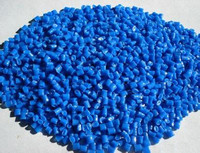ABS recycled material is a new type of material with perfect properties. What are the functions of ABS plastics? Let's learn about it today.

There are many types of ABS resin, but the basic requirements of the colorants used are good heat resistance and weather resistance, and strong covering power. The commonly used coloring agents are titanium dioxide, cadmium pigments, iron red, ultramarine, carbon black and other inorganic pigments, phthalocyanine pigments, quinacridone organic pigments. Because ABS contains rubber components, coloring will present uneven color. Different dyeing, different reflection, different color light.
If the color is thicker, it can compensate for this defect. Therefore, when ABS plastic granule manufacturers produce, the amount of coloring agent is relatively large, generally about 2%; the amount of titanium dioxide added is even as high as 10%. The amount of colorant is large, so it is necessary to consider the laxity of colorants. In addition, ABS resin is easy to change color when heated and irradiated by ultraviolet light, so it is necessary to select pigments with small change. The effect of pigment on the UV aging of ABS resin is the same as that of polystyrene and other plastics. The UV irradiation of ABS recycled materials will promote the aging, especially the rubber with dimer combination is more easily affected by UV. Therefore, if the product is exposed outdoors for a long time, it will change color and reduce the impact strength. However, if the ABS material is mixed with inorganic or organic pigments, its strength will not change even if exposed outdoors for a long time.
In addition, the change of Rockwell hardness and tensile strength is negligible. In the above situation, it is clear that the influence of ultraviolet rays only remains on the surface of colored objects, which reflect or absorb ultraviolet rays, and then form an outer layer to maintain the interior. The inner part of the molding material is hardly affected by ultraviolet radiation, so the physical properties change little. In contrast, the aging degree of natural resin is significant. Generally, the greater the UV absorption capacity of pigments, the greater the inhibition of aging. Therefore, the influence on the resin should be fully considered when selecting the pigments for ABS resin. For example, the plastic particles of ABS recycled materials used outside the room should be used with suitable pigments with high concentration and strong covering power as far as possible, so as to improve the light resistance of the polymer itself.
